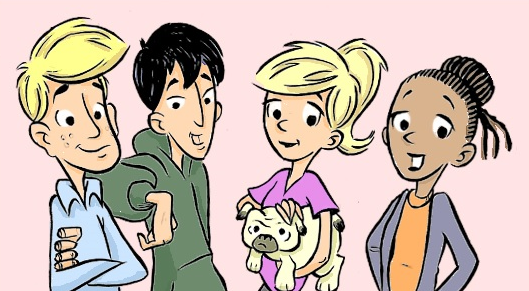Decodables for Big Kids
 The Sam and Friends Phonics Books have been designed to support systematic and explicit phonics instruction, such as is included in the author’s comprehensive Teaching Reading Strategies and The Science of Reading Intervention Program.
The Sam and Friends Phonics Books have been designed to support systematic and explicit phonics instruction, such as is included in the author’s comprehensive Teaching Reading Strategies and The Science of Reading Intervention Program.
The Sam and Friends Phonics Books have been designed to support systematic and explicit phonics and spelling instruction. The eight-page books will help your students master all the common sound-spelling patterns and 108 high frequency Heart Words (words with one or more irregular sound-spellings), while improving their reading fluency and comprehension.
What makes these decodables ideal for older students?
For years I served as an upper elementary reading specialist and middle-high school reading intervention teacher. I, like others who teach older, vulnerable/struggling readers, simply could not find decodable stories which specifically helped students practice the sound-spellings I was teaching.
Using the “Bob” books, Dr. Seuss, or the ilk was out of the question. Nothing de-motivates an older student more than primary age-appropriate illustrations and/or story themes in books or in reading curriculum.
Yes, many of these older readers do need to know how to sound out “c-aa-t,” but “there must be better ways to practice the /k/, short /a/, and /t/ sounds and c-a-t spellings,” I thought. I searched high and low, and no… High/Low readers were not the answer. I searched the Reading Rockets decodable links in vain. I wanted targeted, pure (as much as possible) decodables with focused sound-spellings and minimal Heart Words that respected my students ages and maturity levels. There simply are no other decodables I could find that met my personal criteria.
I had to write them.
Of course, I can’t draw an engaging illustration to save my life. But David Rickert, the comic artist, certainly can. A true partnership developed. I wrote the stories about the adventures of Sam and his friends: Tom, Kit, and Deb. Oh, and also Sam’s dog, Pug. The plots for each self-contained story reinforce positive values and character development and feature multi-ethnic teenage characters. David illustrated each of the 54 Sam and Friends Phonics Books.
Now, David is a high school ELA teacher, in addition to being an illustrator. He found it interesting that I insisted on illustrations which did not add meaning to the stories, but only entertained the readers. If you are knowledgeable about S0R (the science of reading), you will understand why we don’t want developing readers to be overly-dependent upon pictures to explain what the text means.
What are the characters like and what are some of the themes in these books?
The four characters and dog interact in and out of the high school setting. Two of them, Sam and Kit, develop a semi-romantic relationship throughout the 54 books. The multi-ethnic characters run counter to many cultural stereotypes. For example, both Tom and Kit are the athletes. Deb, an African-American, is the smart debate club champion with math and science as her strong suits. Sam’s dog, Pug, is a trouble-making, but lovable, pooch.
The story themes take place in a variety of settings: in school, at the lake, at the ocean, in the forest, at the coffee shop.
In one story, Tom and Sam create a snow tubing business; in another, Deb and Kit run a race; in a story featuring Pug, the dog chases the ice cream truck. In each story, positive values are emphasized. There is nothing overly controversial in these stories… they teach the values of friendship, respect to parents and teachers, loyalty, honesty, etc. However, these aren’t preachy stories, although in one story all four friends visit Deb’s church. The stories won’t elicit any parent or student complaints… they teach your students to read and even enjoy the practice.
Also included in these stories are the focus sound-spellings, Heart Words, 30-second word fluencies, 5 higher level comprehension questions, and comment or question text boxes. Each of the 54 stories connects to the sounds and spellings instructional sequence from my two reading intervention programs. No, I don’t sell the Sam and Friends Phonics Books separately. They are completely integrated into my two programs listed below. Yes, the books are formatted for interactive reading in Google slides, but also may be printed as eight-page booklets or viewed on tablets, Chromebooks, and phones. So many ways to read these stories and practice what you teach!
These phonics books are ideal for guided reading and independent practice in all reading intervention instructional settings. Check out this quick video, featuring one of the Sam and Friends Phonics Books: https://www.youtube.com/watch?v=q6qxzT6OoOI Now, once you’ve watched the video… if you are a reading nerd like me, you’ll want more technical reading stuff about just how decodable these books are, and just how aligned the series is to the science of reading. Check out Decodables Criteria and nerd out!

The Teaching Reading Strategies (Intervention Program) is designed for non-readers or below grade level readers ages eight–adult. This full-year, 55 minutes per day program provides both word recognition and language comprehension instructional resources (Google slides and print). Affordable, easy-to- teach, and science of reading-based, featuring the Sam and Friends Phonics Books–decodables designed for older students. The word recognition activities and decodables are also available as a half-year option in The Science of Reading Intervention Program.
PREVIEW TEACHING READING STRATEGIES and THE SCIENCE OF READING INTERVENTION PROGRAM RESOURCES HERE.
